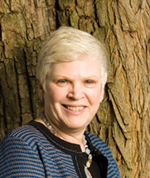A Time to Plant

Amy Edwards
Photo by Ron Aira
A lot of trees have to die so lawyers can do their work. Even in this age of digital communications, most of a typical lawyer’s work output—all those briefs, pleadings, contracts, letters and memos to file—ends up on paper. And we all know where paper comes from.
Depending on his or her practice setting, a lawyer uses anywhere from 20,000 to 100,000 sheets of paper a year, according to an informal sampling of law firms conducted in 2006 by Arnold & Porter. It takes a dozen trees to feed the paper needs of a lawyer at the upper end of that scale.
But now it’s payback time.
In 2007, the ABA—working primarily through its Section of Environment, Energy and Resources—teamed with the U.S. Environmental Protection Agency to launch the Law Office Climate Challenge. One of the program’s goals is to encourage law firms to use less paper. More than 200 law firms and other organizations are now participating. (See “Ending the Paper Chase,” ABA Journal, January 2008.)
And in March, the section launched a project that will put trees back into the ground—literally. The goal of the One Million Trees Project is for lawyers to take responsibility for planting that many trees around the U.S. by 2014.
The idea for the project was triggered by the growing interest in tree planting among cities aiming to improve their urban environments, says Amy L. Edwards, who chairs the section’s Environmental Transactions and Brownfields Committee, which is coordinating the One Million Trees Project.
“It seemed like something that our committee had a natural interest in, in terms of our focus on sustainability issues in urban environments,” says Edwards, a partner with Holland & Knight in Washington, D.C.
GOOD TREE, STAY
There are a lot of good reasons for the initiative, says Ann M. Rhodes, a member of the environmental transactions committee. Trees combat climate change by pulling carbon dioxide out of the air and replacing it with fresh oxygen. They also provide shade and cooling, which reduces the need for air conditioning and saves energy. They protect water supplies by preventing erosion and runoff, helping to keep sediment and chemicals out of streams.
“And of course they’re beautiful, and a lot of studies show that people in urban areas feel better with trees in their environment,” says Rhodes, who helped identify partners for the project.
Those partners—all nonprofit organizations—are the Alliance for Community Trees, which specializes in planting trees in urban areas; the Arbor Day Foundation and American Forests, which focus on restoring ecologically distressed woodlands; and TreeLink/TreeBank, which distributes funds to support local tree-planting efforts.
One way for lawyers to participate in the project is to donate money to one of the partner organizations for their tree-planting projects. But lawyers who want to get their hands a little dirty by conducting their own tree-planting programs may contact a fifth project partner, the Institute for Environmental Solutions, for startup assistance. The partners will report on lawyer participation to the project so it can tabulate the climb to the target of 1 million trees. Even lawyers who plant trees in their own yards or communities may contribute to the project’s goal by filling out a form on its webpage.
A million trees in the next five years is an ambitious goal, concedes Rhodes, who is an associate at Berg Hill Greenleaf & Ruscitti in Boulder, Colo. But, she says, “if only half of the 400,000 members of the ABA plant one tree a year, in five years we will meet our goal.”



